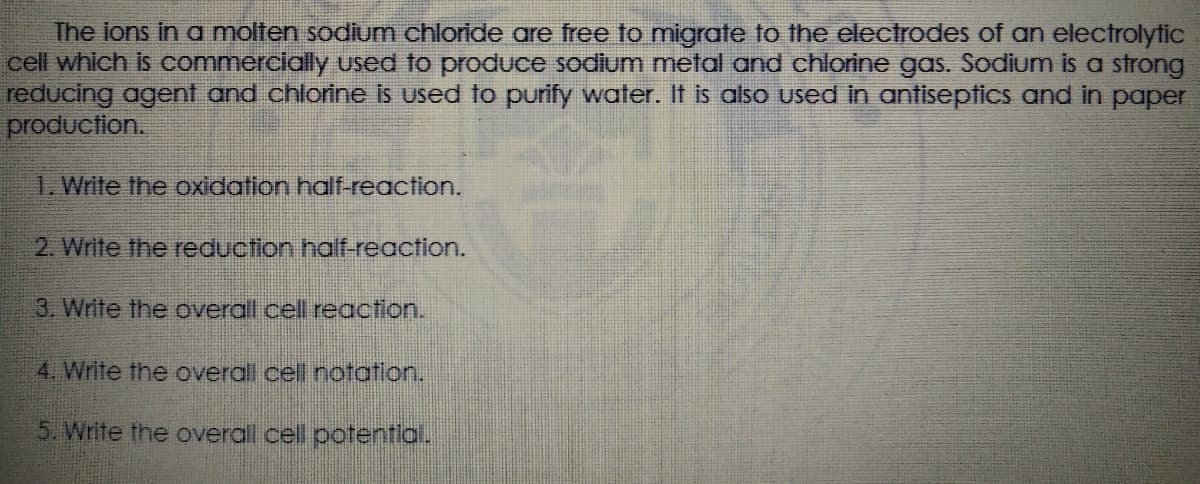The ions in a molten sodium chloride are free to migrate to the electrodes of an electrolytic cell which is commercially used to produce sodium metal and chlorine gas. Sodium is a strong reducing agent and chlorine is used to purify water. It is also used in antiseptics and in paper production. 1. Write the oxidation half-reaction. 2. Write the reduction half-reaction. 3. Write the overall cell reaction.
The ions in a molten sodium chloride are free to migrate to the electrodes of an electrolytic cell which is commercially used to produce sodium metal and chlorine gas. Sodium is a strong reducing agent and chlorine is used to purify water. It is also used in antiseptics and in paper production. 1. Write the oxidation half-reaction. 2. Write the reduction half-reaction. 3. Write the overall cell reaction.
Introductory Chemistry: An Active Learning Approach
6th Edition
ISBN:9781305079250
Author:Mark S. Cracolice, Ed Peters
Publisher:Mark S. Cracolice, Ed Peters
Chapter19: Oxidation-reduction(electron Transfer) Reactions
Section: Chapter Questions
Problem 59E: As an example of an electrolytic cell, the text states: Sodium chloride is electrolyzed commercially...
Related questions
Question
100%
Electrolytic Cell

Transcribed Image Text:The ions in a molten sodium chloride are free to migrate to the electrodes of an electrolytic
cell which is commercially used to produce sodium metal and chlorine gas. Sodium is a strong
reducing agent and chlorine is used to purify water. It is alsO used in antiseptics and in paper
production.
1. Write the oxidation half-reaction.
2. Write the reduction half-reaction.
3. Write the overall cell reaction.
4. Write the overall cell notation.
5. Write the overall cell potentlal.
Expert Solution
This question has been solved!
Explore an expertly crafted, step-by-step solution for a thorough understanding of key concepts.
This is a popular solution!
Trending now
This is a popular solution!
Step by step
Solved in 4 steps

Knowledge Booster
Learn more about
Need a deep-dive on the concept behind this application? Look no further. Learn more about this topic, chemistry and related others by exploring similar questions and additional content below.Recommended textbooks for you

Introductory Chemistry: An Active Learning Approa…
Chemistry
ISBN:
9781305079250
Author:
Mark S. Cracolice, Ed Peters
Publisher:
Cengage Learning

World of Chemistry, 3rd edition
Chemistry
ISBN:
9781133109655
Author:
Steven S. Zumdahl, Susan L. Zumdahl, Donald J. DeCoste
Publisher:
Brooks / Cole / Cengage Learning

Chemistry: Principles and Reactions
Chemistry
ISBN:
9781305079373
Author:
William L. Masterton, Cecile N. Hurley
Publisher:
Cengage Learning

Introductory Chemistry: An Active Learning Approa…
Chemistry
ISBN:
9781305079250
Author:
Mark S. Cracolice, Ed Peters
Publisher:
Cengage Learning

World of Chemistry, 3rd edition
Chemistry
ISBN:
9781133109655
Author:
Steven S. Zumdahl, Susan L. Zumdahl, Donald J. DeCoste
Publisher:
Brooks / Cole / Cengage Learning

Chemistry: Principles and Reactions
Chemistry
ISBN:
9781305079373
Author:
William L. Masterton, Cecile N. Hurley
Publisher:
Cengage Learning

Chemistry: The Molecular Science
Chemistry
ISBN:
9781285199047
Author:
John W. Moore, Conrad L. Stanitski
Publisher:
Cengage Learning

General Chemistry - Standalone book (MindTap Cour…
Chemistry
ISBN:
9781305580343
Author:
Steven D. Gammon, Ebbing, Darrell Ebbing, Steven D., Darrell; Gammon, Darrell Ebbing; Steven D. Gammon, Darrell D.; Gammon, Ebbing; Steven D. Gammon; Darrell
Publisher:
Cengage Learning

Chemistry: Matter and Change
Chemistry
ISBN:
9780078746376
Author:
Dinah Zike, Laurel Dingrando, Nicholas Hainen, Cheryl Wistrom
Publisher:
Glencoe/McGraw-Hill School Pub Co